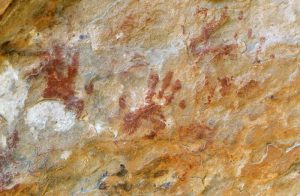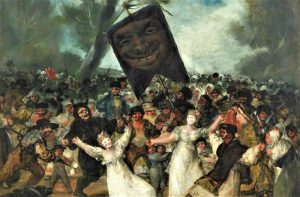Rock art
Over time, man has left his mark through drawings on walls, stones and caves. He has represented with his art, innumerable scenes of his life on earth, human and animal figures are common to find, plants and objects to represent their properties, signs and geometric figures to communicate, all these artistic drawings show the skill, intelligence and thinking form they had. It is very likely that before writing was invented, the drawings shown in these places were their means of communication, to record their beliefs and thoughts.

Related topics
Baroque art, Byzantine art, Egyptian art, Greek art, Medieval art, Roman art, Romanesque art
What is Rock Art?
Rock art is essentially a primitive expression that is reflected in practically all periods of human history. It is the representation in stones, walls or caves of objects, different animals, plants, life histories, geometric figures and signs as a form of communication. It is the first form of artistic manifestation of the human being in the Prehistoric era, long before writing was invented.
It is known as Rock art the traces that have had the activity of men or images that have been drawn and engraved on any type of surface based on rocks. All these artistic manifestations are a reflection of the great capacity that our ancestors had to represent their daily life.
Characteristics of Rock art
The drawings represent animals, mainly bulls, mammoths, horses and bison. It is not very common to find human figures, although it has been verified. Many of these images are symbolic. The use of polychromy is an important feature. They obtained colors through natural elements such as charcoal and earth by mixing them with vegetable juices and eggs. They used to represent hunting activities. They are generally located in caves and stones. It is common to find sculptures. It was a type of sculpture mainly focused on women and their physical attributes and is believed to be specifically related to motherhood and fertility. They did not have a specific painting technique because they basically used their fingers to elaborate their art.
History of Rock art
By the middle of the 19th century in Europe, it had been possible to locate in different caves, some objects sculpted in stone with specific representations of animals. In 1879 the cave paintings were discovered for the first time. One of the first caves studied was a cave in Altamira (Spain) where drawings representing bison in different colors were found. At first, this discovery was denied by the community of artists and scientists, but later the importance it deserved would be given as more finds were made in other cave sites in Spain and other countries. From that moment on, scientists have dedicated themselves to researching this type of primitive art.
Important figures
Cave art involves a great variety of figures and drawings. Petroglyphs are images engraved on rock surfaces. They are known as rupestrian engravings and were carved in rocks with hard instruments such as pointers, that were made for this purpose. Pictographs were also prominent figures in Rock art. They were graphisms elaborated on rocks with pigments and it was known as rupestrian painting. They used mixtures elaborated with minerals, vegetables and animal products, and in this way they were able to obtain color. These pigments were placed with fingers or with instruments similar to a brush.
Rock art in America
The cave of the hands located in Argentina, offers us an example of cave art. You can see figures of hands, animals, hunting scenes. The Sierra de San Francisco in Mexico was a city inhabited by people who inherited the best samples of cave paintings. Thanks to the climate, they have been conserved in perfect condition. They illustrate human beings and animals.
Rock art in Asia
In Huashan, a town in southeast China, we can find one of the largest stone murals in the world. With more than 1,800 different figures representing animals and swords ranging from 30 cm to 3 meters high.
Rock art in Africa
Tassili n’Ajjer is located in the Sahara desert. More than 15,000 paintings and engravings made in stone record figures of migrating animals and the evolution of life in the place. The Drakensberg Park in South Africa has an impressive number of paintings related to the native inhabitants of the region. Located in caves and rocks, the pictorial panels are used to identify animals and human representations.
Rock art in Oceania
Kakadu National Park in Australia is one of the world’s leading archaeological reserves. All the engravings, paintings and places reflect the life of its people, hunters and gatherers from prehistoric times to the present who still continue creating cave art.
How to cite this article?
Briceño V., Gabriela. (2019). Rock art. Recovered on 24 February, 2024, de Euston96: https://www.euston96.com/en/rock-art/









